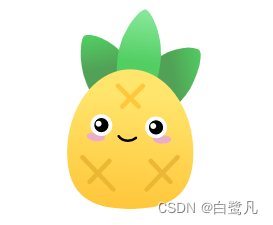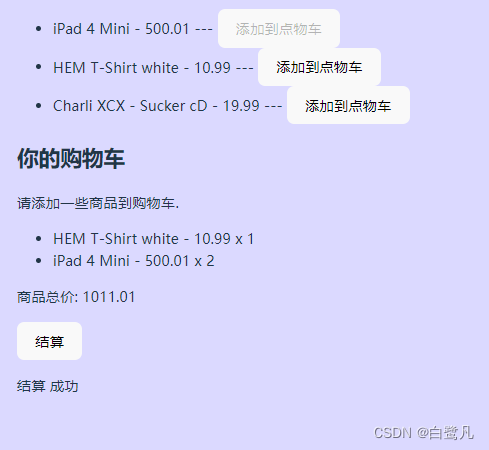
官网:https://pinia.web3doc.top/
一、Pinia API与Vuex s4 有很大不同
- 没有 mutations。mutations 被认为是非常几长的。最初带来了 devtools 集成,但这不再是问题
- 不再有模块的嵌套结构您仍然可以通过在另一个 store 中导入和使用 store 来隐式嵌套 store,但 Pinia 通过设计提供扁平结构,同时仍然支持 store 之间的交叉组合方式。您甚至可以拥有 store 的循环依赖关系。
- 更好 typescript 支持。无需创建自定义的复杂包装器来支持 TpeScript,所有内容都是类型化的,并且 AP 的设计方式尽可能地利用 TS 类型推断。
- 不再需要注入、导入函数、调用它们,享受自动补全!
- 无需动态添加 stores,默认情况下它们都是动态的,您甚至不会注意到。请注意,您仍然可以随时手动使用 store 来注册它,但因为它是自动的,所以您无需担心。
- 没有命名空间模块。鉴于 store 的扁平架构,"命名空间"stre 是其定义方式所固有的,您可以说所有 stores 都是命名空间的.
Pinia 就是更好的 Vuex,建议在你的项目中可以直接使用它了,尤其是使用了TypeScript 的项目。
二、使用步骤
1.安装
yarn add pinia
// 或者使用 npm
npm install pinia
2.使用
在main.ts里面映入
import {
createApp ] from 'vue'
import App from './App.vue'
import {
createPinia } from 'pinia'
// 创建
const pinia = createpinia()
const app = createApp(App)
// 挂载到 Vue 根实例
app.use(pinia)
app.mount('#app')
新建store文件夹。在文件夹下面新建index.ts。
import {
defineStore } from 'pinia'
// 1.定义并导出容器
// 参数1: 容器的 ID,必须唯一,将来 Pinia 会把所以的容器挂载到根容器
// 参数2: 选项对象
export const useMainStore = defineStore( 'main',{
// 类似于组件的 data,用来存储全局状态的
// 1、state必须是函数: 这样是为了在服务端染的时避免交叉请求导致的数据状态污染
// 2、必须是箭头函数,这是为了更好的 TS 类型推导
state: ()一{
return {
};
},
// 类似于组件的 computed,用来封装计算属性,有缓存的功能
getters: {
count10 (state) {
// state可选参数
console.log('count10 调用了')
return state.count + 10
}
},
// 类似于组件的 methods,封装业务逻辑,修改 state
actions: {
changestate (num:number) {
this.count+=num
}
}
})
// 2.使用容器中的 state
// 3.修改 state
// 4.容器中的 action 的使用
3、组件中应用
<template>
<div> {
{
mainStore.count }} </div>
<div> {
{
count }} </div>
<button @click="handleChangeState">修改数据</button>
<div>{
{
mainStore.count10 }}</div>
<div>{
{
mainStore.count10 }}</div>
</template>
<script lang="ts" setup>
import {
useMainStore } from ' .. /store'
import {
storeToRefs } from 'pinia'
const mainStore = useMainStore( )
console.log(mainStore.count )
const {
count] = storeToRefs(mainStore)
//修改数据
const handleChangestate = ()=> {
// 方式一: 最简单的方式就是这样
mainStore.count++;
// 方式二: 如果需要修改多个数据,建议使用 $patch 批量更新
mainStore.$patch({
count: mainStore.count + 1,
})
// 方式三:使用$patch 传递一个函数,也是批量更新
mainStore.$patch( state=>{
state.count++;
})
// 方式四: 逻辑比较多的时候可以封装到 actions 做处理
mainStore.changeState(10)
}
</script>
如果在组件中把mainStore数据解构出来,那么数据不是响应式的了,需要使用storeToRefs 去解构。实质是将解构出来的数据做ref代理处理。
多个数据批量修改有利于性能优化,因为一个一个改数据会触发一次又一次的视图更新,批量修改只会触发一个视图更新。
注意:不能使用箭头函数定义 action,因为箭头函数绑定外部 this
案例
商品列表
。展示商品列表、添加到购物车
购物车
。展示购物车商品列表、展示总价格、订单结算、展示结算状态。
效果如下图:

新建商品组件 ProductList.vue
<template>
<ul>
<li v-for="item in productsStore.all">
{
{
item.title }} - {
{
item.price }}
---
<button :disabled="item.inventory <= 0" @click="cartStore.addProductToCart(item)">添加到点物车</button>
</li>
</ul>
</template>
<script setup lang="ts">
import {
useCartStore } from '../store/cart';
import {
useProductsStore } from '../store/products';
const productsStore = useProductsStore()
const cartStore = useCartStore()
// 加载数据
productsStore.loadAllProducts()
</script>
新建购物车 Shoppingcart.vue
<template>
<div class="cart">
<h2>你的购物车</h2>
<p>
<i>请添加一些商品到购物车.</i>
</p>
<ul>
<li v-for="item in cartStore.cartProducts">{
{
item.title }} - {
{
item.price }} x {
{
item.quantity }}</li>
</ul>
<p>商品总价: {
{
cartStore.totalPrice }}</p>
<p>
<button @click="cartStore.checkout()">结算</button>
</p>
<p v-show="cartStore.checkStatus">结算 {
{
cartStore.checkStatus }}</p>
</div>
</template>
<script setup Tang="ts">
import {
useCartStore } from '../store/cart';
const cartStore = useCartStore()
</script>
在api文件下 新建 shops.ts 文件,用于模拟调用数据接口
export interface IProduct {
id: number
title: string
price: number
inventory: number // 库存
}
const _products: IProduct[] = [
{
id: 1, title: 'iPad 4 Mini', price: 500.01, inventory: 2 },
{
id: 2, title: 'HEM T-Shirt white', price: 10.99, inventory: 10 },
{
id: 3, title: 'Charli XCX - Sucker cD', price: 19.99, inventory: 5 },
]
export const getproducts = async () => {
await wait(100)
return _products
}
export const buyProducts = async () => {
await wait(100)
return Math.random() > 0.5
}
async function wait(delay: number) {
return new Promise((resolve) => setTimeout(resolve, delay))
}
在src目录下新建store 文件,下面新建cart.ts和 products.ts
products.ts 代码如下:
import {
defineStore } from 'pinia'
import {
getproducts,IProduct} from "../test/api/shops"
export const useProductsStore = defineStore('products', {
state: () => {
return {
all:[] as IProduct[] // 所以商品列表
}
},
getters: {
},
actions: {
async loadAllProducts () {
const ret = await getproducts()
this.all = ret
},
// 减库存
decrementProduct(product:IProduct){
const ret = this.all.find(item=> item.id === product.id)
if(ret){
ret.inventory--
}
}
}
})
cart.ts 代码如下:
import {
defineStore } from "pinia";
import {
IProduct, buyProducts } from "../test/api/shops";
import {
useProductsStore } from "./products"
type CartProduct = {
quantity: number
} & Omit<IProduct, "inventory"> // 合并IProduct类型数据,Omit 合并IProduct的时候,去除inventory库存这个属性
// IProduct
export const useCartStore = defineStore("cart", {
state: () => {
return {
cartProducts: [] as CartProduct[], // 购物车商品列表
checkStatus: null as null | string,
}
},
getters: {
totalPrice(state) {
// 计算总价
return state.cartProducts.reduce((total, item) => {
return total + item.price * item.quantity
}, 0) // 初始为0
}
},
actions: {
addProductToCart(product: IProduct) {
console.log(product)
// 看商品有没有库存
if (product.inventory < 1) {
return
}
// 检查购物车中是否已有该商品
const cartItem = this.cartProducts.find(item => item.id === product.id)
// 如果有则让商品的数量 + 1
if (cartItem) {
cartItem.quantity++
} else {
// 如果没有则添加到购物车列表中
this.cartProducts.push({
id: product.id,
title: product.title,
price: product.price,
quantity: 1 // 第一次添加数量是1
})
}
// 更新库存
const prostore = useProductsStore()
prostore.decrementProduct(product)
},
async checkout() {
const res = await buyProducts()
this.checkStatus = res ? '成功' : '失败'
}
}
})